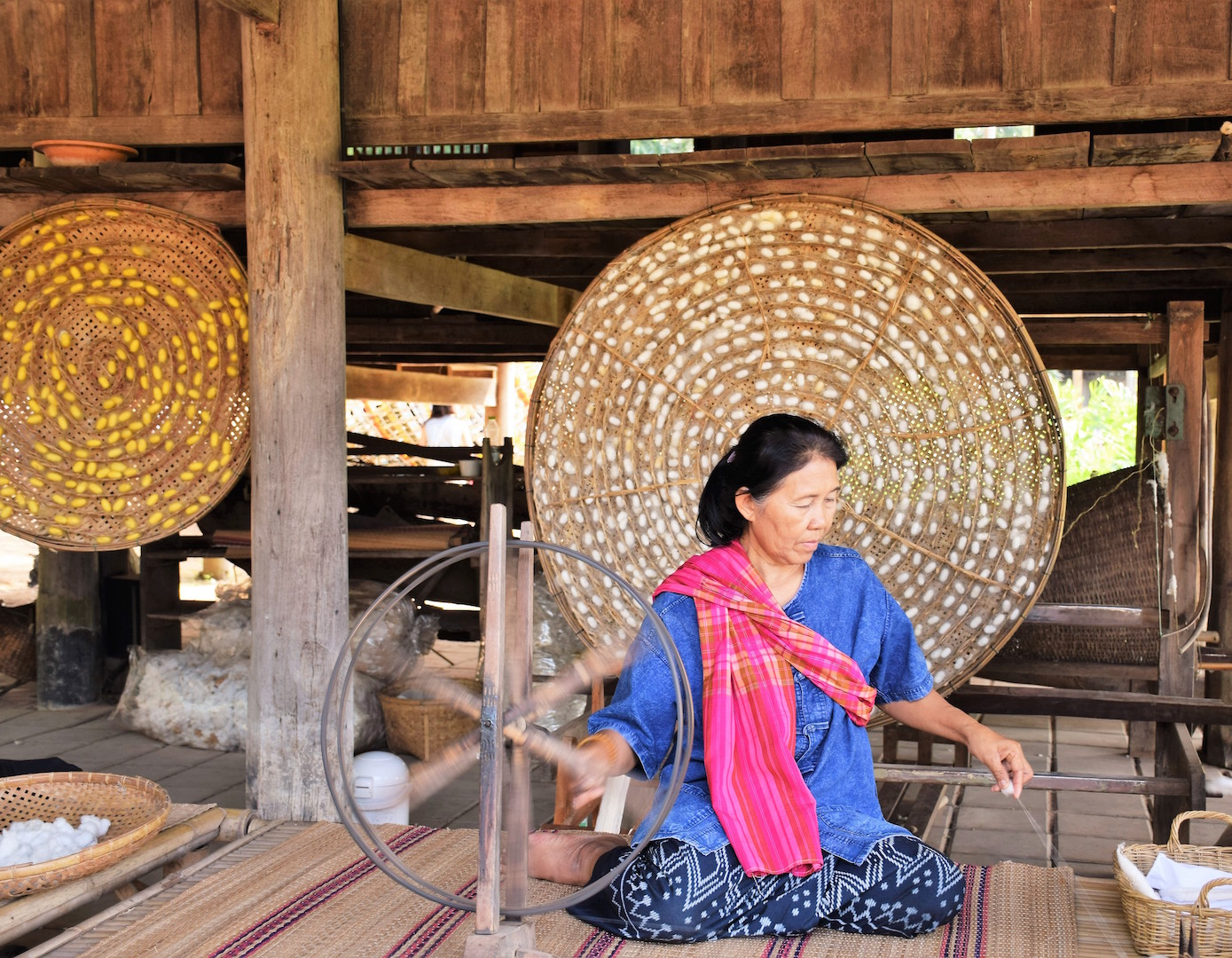A Modern Life & Thai Textiles – Treasures of a Kingdom
Thailand remains a country of weavers and wooden looms, artisans making traditional Thai Textiles – Treasures of a Kingdom by hand in a time honoured way despite the rise of mass produced, industrially manufactured materials and fashion.
Northern Hill Tribe Textiles
Chiang Mai offers an amazing insight into Thai textiles via the ethnic dress of the Northern Thai hill tribes. Each tribe, who migrated from the Himalayan foothills to Thailand, has a unique traditional textile tradition that is in contrast with one another as much as they complement.
Silver and gold thread embroidery, seed embroidery, applique and chain stitching of animal and insect motifs are popular adornments. Women of the six most prevalent tribes; Karen, Lisu, Meo, Lahu, Yao and Akha, all go to Chiang Mai markets to sell their hand-woven textiles.
Similarly, the art of Mo Hom has advanced in recent years to meet the desires of creative consumers looking for authentic artisan products. Mo Hom is cotton fabric manipulated into various patterns using the strength of the dye and time soaked in the solution, producing stunning shades of indigo across a spectrum from dark navy to sunlight blue.
Southern Region Textiles
The textiles of Southern Thailand exhibit characteristics and influences of those from Malaysia and or Indonesia’s island of Sumatra. Pha Yok is a rare cloth woven only in Nakhon Si Thammarat and Trang provinces. It is another type of fabric that was favoured in the past by royals and people of noble birth. It is like Songket (a Malaysian cloth) and requires high-skilled weavers and complicated techniques. Gold and silver thread woven into this kind of cloth creates its lustrous texture.
Hang Karok is a technique unique to the Southern Region that uses two-coloured twisted thread before woven. Centres of production include villages around Trang and in the Songkhla Lake area.

Northeast Mudmee Magic
The diversity of the ethnic people who settled in villages on the Khorat Plateau led to an abundance of different weaving styles, producing a vast array of silk and cotton textiles. Each is unique and beautiful on its own right as every Northeastern or Isan village will have its own signature style.
Mudmee silk is a staple of the Northeast region weaving industry and H.M. Queen Sirikit is very fond of this kind of silk. Though it can be woven from cotton yarn, Mudmee is regarded as the ‘Queen of Thai Silk’ because of the Thai Queen and the textile’s intricate patterns.
It is woven in almost all provinces in the Northeast region; such as, Khon Kaen, Nakhon Ratchasima, Roi Et, Surin, Buri Ram and Si Sa Ket.
Women Weavers
Village-based weaving is and has been a way of life for generations. The locally-produced fabrics date from a rich history of cultural-based materials and clothing, are often made in the same way they have been for generations and sold at local markets across the country.
It gives visitors a chance to experience the authentic weaving heritage personally plus put travel dollars direct into Thailand’s textile rich destinations. Every trip provides an opportunity to support local weavers, sustaining the trade for future generations whilst gaining valuable firsthand knowledge on how to buy incredible fabrics in Thailand.
In the Isan region, women find strength, merit and economic status through traditional textile production. Buying direct from weavers or local markets in small Thai villages empowers women whilst supporting the local economy and small businesses.
Thai Textile Buyers Guide
Haggling is part of the fun of marketing shopping. Strolling through exotic markets and finding beautiful textiles and fabrics and securing a good deal is exciting. But it is important to approach in the spirit of fair play and understanding of the local economy.
Show respect to sellers by having the right attitude, dress and act appropriately for the environment. Smile and always be respectful towards all sellers, as it can make the interaction feel more authentic, and maybe help all involved get a better deal.
But when travelling to source handmade village-based textiles it is important to remember sometimes the best price is the one that supports the artisan. It is always best not to get a bargain at someone else’s expense. Especially every tourist dollar that goes directly to women weavers of Thailand usually goes a long way to help support them or their extended families.





